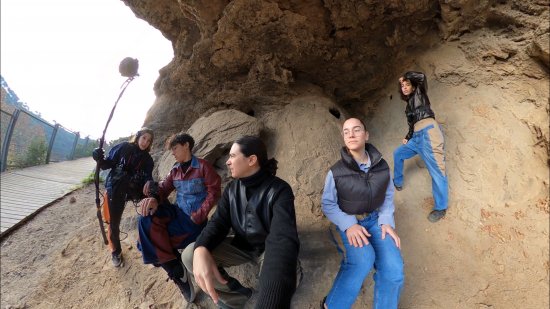- Exhibition program
- Fixations per Minute
- Artist
- Claudia Pagès
- Dates
- —
- Place
- Espai 13
- Curated by
- Yaby (Beatriz Ortega Botas and Alberto Vallejo)
The exhibition Banditry by Claudia Pagès presents a new investigation focused on stamped paper, watermarks and other marks which explores their relation to the circulation of power and the material substrates upon which meanings are fixed. Pagès thus continues her research into the formal, corporeal and spatial consequences of the text, taking elements from language and visually extrapolating these in order to submit them to unfamiliar interactions. Here the room is divided into two by a wall of paper featuring watermarks created by the artist; on each side of the wall is a projection screen - on the same axis and facing each other, they alternately reproduce parts of the same audiovisual piece. The title also speaks to a system of opposites: beyond its romantic image, banditry was a complex phenomenon financed by the nobility who organised bands of men and women that, apart from robbing traders, served the interests of one feudal lord against the others, consistent with the power relations in a lord-vassal social structure. The concept of taking sides, or bands, runs through the exhibition: friends, enemies, walls, dilemmas, dualisms, their hierarchies and complications, and that which is deeper and less visible underlying and sustaining them.
A watermark is an integrated mark - typically an image or a pattern - created via thickness differences in the manufacture of paper. More or less complex designs, logos or letters delineated in copper wire are attached to the paper mould, preventing the paper pulp from reaching its maximum density at the points of the wire and causing marks to emerge through absence; these can typically only be seen when looking at the sheet against light. In the wall of watermarked paper, the marks are only visible from the side that remains in darkness when the projector on the other side is turned on, revealing the wall as both a carrier and an interceptor of meanings. Pagès is interested in the way these marks foster communication without establishing a definitive reading. They operate within a system of meanings and values in which power flows and is exerted almost invisibly. In the eighteenth century, Capellades, the artist's hometown, acquired great prestige with the production of stamped paper, which was used primarily for judicial and administrative documents and as a tool for identification, legitimisation, colonisation, property and control.
The video projected on both sides of the wall was filmed in two locations in Capellades: the Museu Molí Paperer, which houses an important historical collection of stamped paper; and Abric Romaní del Capelló, a Neanderthal archaeological site that preserves marks from different periods engraved on its stone walls. Both the museum and the Palaeolithic cliff have accumulated signs that transit in an ambiguous space between words and images. The video was filmed with three GoPro cameras mounted on three different bodies which form a parallel with the three points of view articulated in Edgar Allan Poe's "The Purloined Letter": the person who sees, the one who does not see, and the one who sees that the other does not see anything. In the story, a letter - the content and sender of which remain unknown - sets off a web of blackmail. The letter, similarly to a watermark, exerts its power through its inherent circulability, and not through the fixed, comprehensible meaning of what it says - the moment the letter is opened and its contents are revealed, it loses its power as a control mechanism. Ultimately, in Poe's story it is the ability to identify with the other, to switch sides, which leads its protagonist Detective Dupin to find the stolen letter and deactivate it. In the video, they play at "reading" marks by pointing towards the sign without fully reaching it, breaking up the signifiers until they lose - or acquire more - meaning, hollowing out the images, stripping them of accumulated time and imagery.

Follow this exhibition on social media
Press Office
Check the exhibition's press materials
Exhibition catalogue
In collaboration with:


